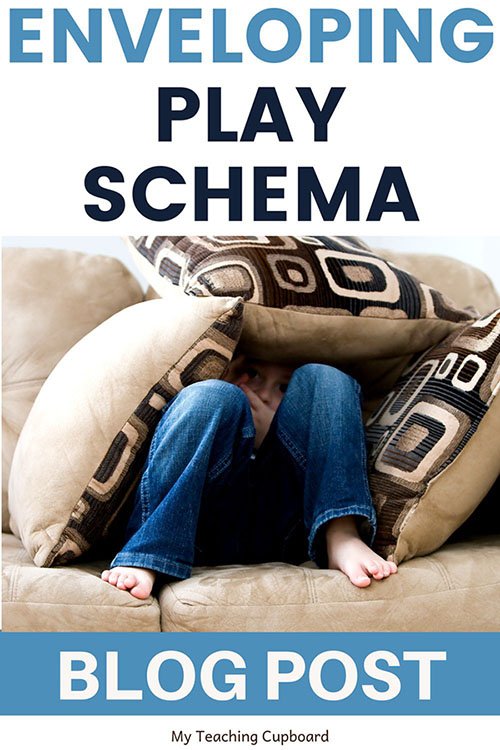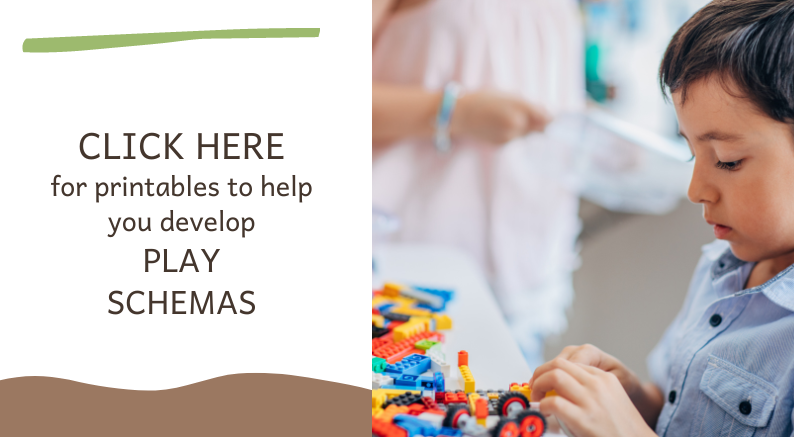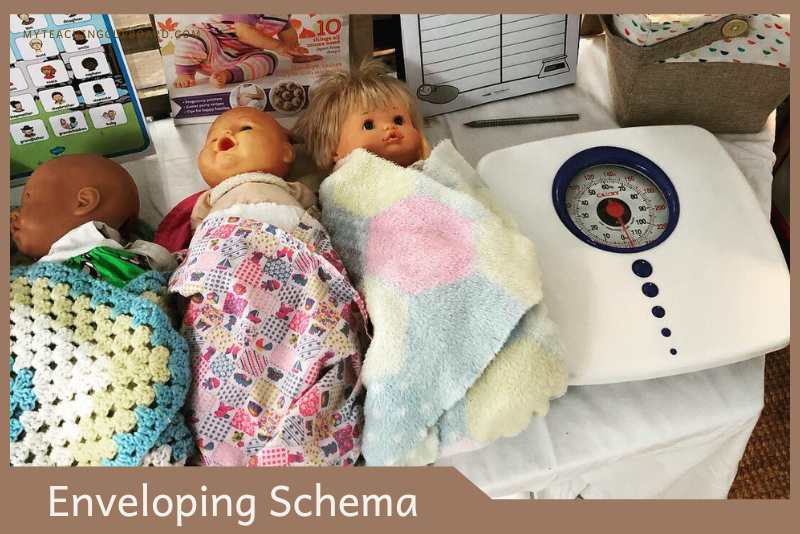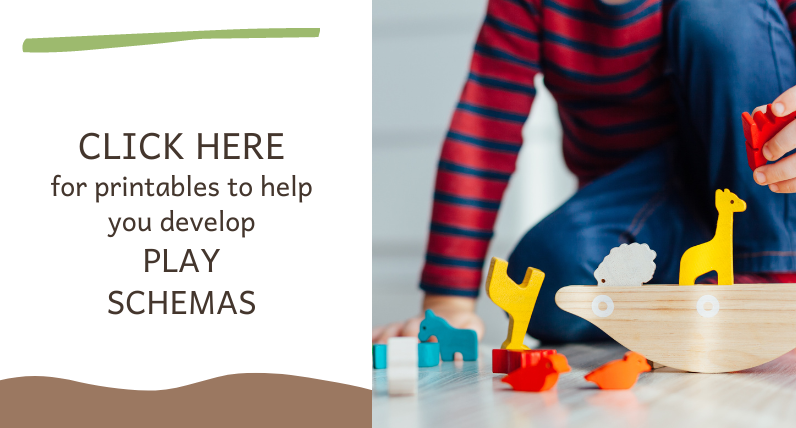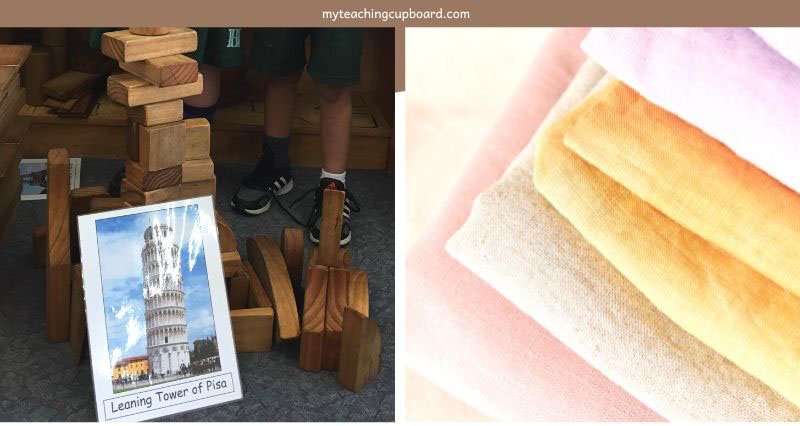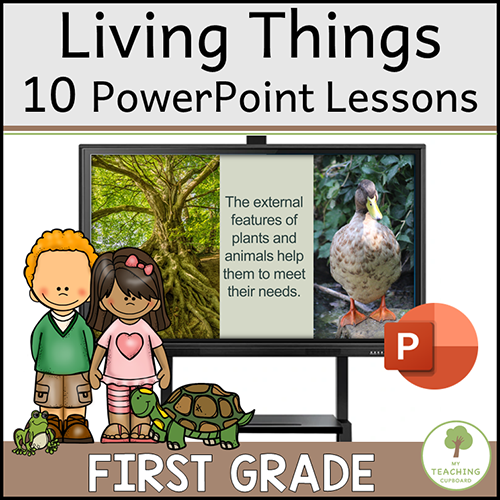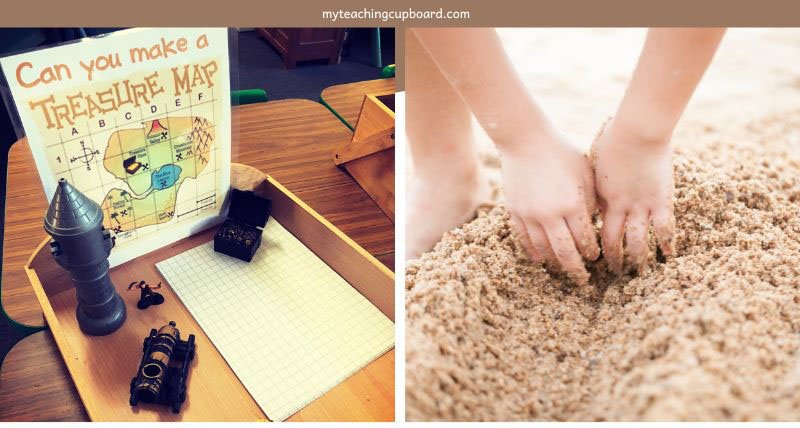The Enveloping Schema
The Enveloping Schema is one of the most common play schemas in early childhood. Do you have students interested in wrapping, covering, or hiding objects or themselves? Children often use materials like blankets, towels, or even cardboard boxes to do this. If you do - then you have students with the enveloping play schema.
You might think enveloping play isn’t related to your learning intentions, but it actually has numerous benefits for a young learner's cognitive, physical, and emotional development.
In this blog post, we'll explore the enveloping play schema in-depth and you’ll discover 57 tips and ideas on how you can support it through play-based learning in your classroom.
What Is a Play Schema?
Schemas are the repeated patterns of behaviour you notice your children doing whenever they play. There are nine play schemas most commonly observed in young children.
If you would like to learn more about all of these play schemas, make sure you check out this comprehensive blog post: A Guide to Play Schemas in Early Childhood Education
This guide to play schemas in early childhood education is a blog post explaining exactly what play schemas are and how you can harness the nine play schemas to deliver an age-appropriate and child-centered pedagogy to effectively teach the children in your class.
Schematic play in the classroom relates to how your students are investigating and exploring the learning resources you have on offer in your classroom. It isn’t a specific type of play like dramatic play or sensory play. You will observe play schemas in all areas of the learning environment.
For example, you might notice a child demonstrating schematic play through enveloping. This means the child is interested in wrapping objects or themselves in various materials. You might see them spending a lot of time wrapping the dolls in blankets in the home corner or creating nests or cozy spaces using the cushions and blankets in your reading area.
While these may seem like different forms of play in quite different scenarios, overall, the schema remains the same.
Once you’ve observed a child displaying a specific play schema, you will usually notice the child repeating that same action schematically using a range of different objects and very often their own bodies too.
Why Are Play Schemas Important in a Play-Based Classroom?
Understanding play schemas and being able to pinpoint the ones your students are developing is critical to the success of your early childhood classroom.
When you understand play schemas you
Better understand your students and their developmental needs.
Broaden your understanding of how children learn.
Tap into your student’s interests and create a child-led curriculum.
Increase student engagement.
Know how to encourage your students to become more curious.
Deepen the learning and the intensity of their investigative play sessions.
Make the right observations to inform your planning.
Be able to easily differentiate the learning experiences you offer your students.
You have probably already noticed that not every child in your classroom enjoys the same types of activities. If you have ever gone to the trouble of setting up an amazing learning provocation only to have it left unexplored by your students, then you need to tap into the power of play schemas. As a teacher, understanding play schemas will allow you to tailor your investigation areas and your classroom activities to the developmental interests of your students.
You will be able to engage your students on a much deeper level and easily extend their thinking.
When you understand play schemas you observe and document the learning that is happening in your classroom in a different way. You’ll become more attuned to making the right observations that will help you differentiate and adapt the curriculum to suit the individual needs of your students.
Planning purposeful learning experiences is a breeze when you use your observations and knowledge of play schemas. Schema play can give us extremely valuable insights into children’s passions, interests, and developmental needs.
Understanding play schemas can also help you understand what can sometimes be seen as undesirable classroom behaviours. For example, you might have a child constantly rolling themselves up in the blanket you’ve used to cover a mattress in your classroom reading area. This would be very annoying for you and all the other children trying to read in this space. This behaviour might be seen as undesirable, but when you understand that this behaviour is coming from a child exploring the enveloping play schema, you can set up a learning invitation to accommodate this schema and turn the undesirable behaviour into a desirable one.
When teachers understand why certain behaviours are happening in their classrooms, they quickly discover children do not simply misbehave. There’s always a reason for desirable and undesirable behaviours and often play schemas are that reason.
If you are interested in following the child and a child-led pedagogy, you know how important it is to observe your students for their interests and their developmental needs. You know that your observations should inform your curriculum planning and you design classroom learning experiences accordingly. When you do this, you’ll be creating a thoughtfully prepared learning environment customized to your students.
Recognising and understanding play schemas is vital in any play-based classroom.
What is The Enveloping Schema?
Children with an enveloping schema have an interest in wrapping up objects or themselves. As your students explore the enveloping schema you might notice them completely wrapping up objects in paper or fabric. They might like to colour whole pieces of paper all in one colour or you might see them painting over their entire hand. Children interested in enveloping often create cubbies to hide in too.
You will notice them burying things in the sandpit or in sensory trays. They love to hide objects so they are out of sight. If you have children fascinated with this play schema you will find classroom resources hidden away in the strangest of places. At re-set time, check all your drawers and boxes for any missing resources!
When children are developing the enveloping schema, they are building measurement concepts around shape, space, and volume. Box construction and classroom makerspaces are popular investigation areas for children exploring this schema.
Enveloping is very easily recognised in the classroom. If you observe your students completely covering themselves or objects, you can be confident they are exploring the enveloping play schema.
This play schema is very similar to the enclosing play schema. You can tell the difference because children demonstrating the enveloping schema are usually covering the whole item so that it cannot be seen at all. On the other hand, the enclosing play schema is more about creating borders or a type of fence or enclosure.
Children with the enveloping play schema often find comfort in being enclosed or wrapped up, and they may repeat these activities over and over again. They do this to explore and understand their environment. Sometimes these children are seeking a feeling of comfort and safety. Enveloping gives them a sense of control over their environment and they envelop themselves or their toys to create a feeling of autonomy.
What Are Children Using the Enveloping Schema Learning?
Children exploring their enveloping schema are developing their own body awareness and a sense of self. They are also developing an understanding of object permanence and the concrete nature of objects or how objects maintain their form in different contexts.
These young children are also learning valuable math concepts related to shapes, space, measurement, and volume. As they use this schema in their investigations, they will be:
Developing fine and gross motor skills.
Exploring object permanence.
Learning about cause and effect.
Developing visual tracking skills.
Fine-tuning their spatial awareness.
Using their senses to make scientific observations.
Developing creative and critical thinking skills.
Building science and math skills like predicting, estimating, problem-solving, and measuring.
What Vocabulary Supports the Enveloping Schema?
under, over, in, on, around
above, below, behind
cover, wrap, unwrap, enclose
full, half full/empty, empty
visible, invisible, hidden
transparent, translucent, opaque
Size and shape words – square, large, thick
57 Hands-on Activities to Support an Enveloping Schema in a Play-Based Classroom
In a play-based classroom, your students will already have access to a wide variety of resources that engage and provoke their investigations. When setting up the environment to support the enveloping play schema, consider what materials are available that your children can use to cover and hide objects or themselves.
Because children exploring this play schema will be fascinated with covering, wrapping, and hiding objects, there are numerous hands-on learning experiences you will have the opportunity to offer your students. Supporting this schema in kindergarten and first grade is easy.
Here are 57 activities to get you started.
Exploring the Enveloping Schema through Block Play
1. Provide a variety of open-ended materials like fabric or cardboard boxes that students can use to create tunnels and contained spaces like tunnels in their block constructions.
2. Use mirrors or reflective surfaces to create illusions of depth and space within block constructions. Children will be able to experiment with creating closed-in spaces that appear larger or smaller than they actually are.
3. Add resources that invite children to create block structures that envelop or contain different objects or characters. For example, adding small farm or zoo animals will prompt children to create caves and houses for the animals.
4. Add pictures of real-world buildings to encourage your students to build more complicated enveloped structures. They can create enveloping constructions that contain tunnels or different types of roofs.
5. Add pieces of fabric in different textures so children can wrap the blocks and their constructions.
The Enveloping Schema in the Makerspace and Art Area
6. Children developing this schema love to envelop themselves in boxes. You can supply your students with large cardboard boxes for them to create child-sized houses, cubbies, forts, and castles. If you have enough space, they could connect different sized cardboard boxes for more complicated designs. Children can use paint, markers, or other materials to decorate the boxes and add details such as windows, doors, and signs.
7. Use smaller boxes and resources from the collage trolley to create small worlds and dioramas. Children can use the collage materials to create details such as buildings, streets, and trees.
8. Make worry dolls by wrapping yarn or thread around small sticks or twigs. Children will be able to share their worries with these little dolls.
9. Create abstract paintings using paint and rollers. Children can experiment with different colours and textures to create unique designs by completely covering surfaces with the rollers.
10. Children with the enveloping play schema will enjoy making paper mache masks and bowls because they are made by covering objects like inflated balloons.
First your students will need to cut or tear newspaper into small strips or pieces. They dip the pieces of newspaper into a mix of PVA glue and water. Mix 1 part white glue with 1 part water, or you can make a paste by mixing flour with water.
After they dip the newspaper strips into the glue mixture, they then place them over the surface of the inflated balloon. Your students will need to apply several layers of paper mache to create a sturdy bowl or mask. Allow each layer to dry before adding the next layer. This is particularly engaging for children with the enveloping play schema, as they will be very interested in the multiple layers.
Once they have applied enough layers of paper mache, the bowl needs to dry completely. It’s best to leave it to dry overnight. When the paper mache is completely dry, your students can pop the balloon and carefully remove it. Now they can explore enveloping even further as they decorate their creations with paint and other decorative materials from the collage trolley.
11. Mask-making is a great activity for children with this play schema because the process and the final product both involve enveloping. Your students can create masks using a variety of materials like paper plates, cardboard, and feathers. Children can decorate the masks by covering them with paint, markers, or other materials. Using the masks for role-play or storytelling is a good way to develop oral language too.
12. Explore Kadinsky's circles. Wassily Kandinsky is a famous artist who used concentric circles to create abstract art. Within each square of the grid, he painted circles that share a central point. Your students will enjoy covering a grid with Kandinsky-inspired circles They will be able to experiment with color and shape to create their own abstract designs.
13. When you are learning about 2D or 3D shapes, make sure to add some printed out shape templates to your makerspace. Children exploring their enveloping schema will love to cover these shapes with torn paper or other suitable materials from the collage trolley.
14. One of our favourite activities is creating stained glass pictures using black cardboard templates and coloured cellophane. Children cut out pictures or shape outlines from black construction paper and then glue coloured cellophane behind them. These look so beautiful when displayed on a window.
15. Anything to do with handprints is going to be of interest to students with the enveloping play schema. Your students will love covering their hands with paint. Use rollers or paintbrushes to do this, and then make handprints by pressing their painted hands onto paper. Encourage your students to decorate their handprints with markers or collage materials. They could use them as gifts for family and friends.
If you want some cute handprint activities for the start of the school year, you’ll love my Kissing Hand freebies. Make sure to grab them HERE.
Teacher Tip: Offer disposable gloves to children that don’t like the sensory feeling of paint on their hands but still want the enveloping experience. Disposable gloves will give you a quick and easy clean up too!
16. Adhesive contact paper and stickers are the perfect resources for children with this play schema. Your children will be developing fine motor skills and their creativity. They can use the stickers and pieces of contact to create peel-and-stick designs to completely cover objects like jars or boxes.
Dramatic Play and the Enveloping Schema
17. When celebrating Christmas in your classroom, you can set up a pretend gift-wrapping station with wrapping paper, bows, and tape. Children with the enveloping play schema will enjoy wrapping and unwrapping pretend gifts for each other or for their dolls and stuffed animals in the home corner.
18. Gift wrapping could also be part of a dramatic play post office. A classroom post office provides opportunities for not only the delivery of parcels and gifts, but also letters and cards. Provide your students with envelopes, stamps, and a mailbox.
Your students will be able to learn about enveloping when they wrap their parcels, place their letters and cards in the envelopes, and again when they post their items in the letterbox for delivery.
19. Use socks or stockings stuffed with crumpled paper to create sausages for pretend cooking in the home corner. They could be sold in an imaginary play grocery store too. Children can practice enveloping the crumpled paper in socks or stockings and squeezing it tightly to create the sausage. They can use tongs or other utensils to "cook" and "serve" their homemade sausages.
20. Create a doctor's office or clinic with bandages, stethoscopes, and other medical supplies. Children with an enveloping schema love wrapping their dolls or stuffed animals with bandages.
Want an easy way to make some play bandages for your dramatic play doctors or vets setups? Check out my Play Bandages Tutorial HERE!
21. Provide doll blankets and sheets in home corner. Children can use them when putting their dolls to bed. Your students will like to envelop their dolls or stuffed animals in the blankets.
22. Another great addition to the home corner is a tablecloth. Your students can cover the home corner table with it and set up a formal dining table with plates, cups, and utensils.
23. If you have dolls in your investigation area, make sure to include some fabric or doll clothes. Your children can practice enveloping their dolls in different clothing and accessories.
24. Supply closed containers for loose parts and play food in your dramatic play spaces. Not only will your students like to explore how these containers can be used to contain and hide objects, but they will also use them to practice counting, sorting, and categorizing.
25. In a vet dramatic play area or a pet shop, supply stuffed animals, bandages and pet carriers. Children can practice enveloping their pets in the carriers. They can also use the bandages to wrap and cover their animals to extend their enveloping schema.
26. Create a pretend bakery with loose parts and playdough. Children will enjoy enveloping the loose parts in the playdough to create their baked goods.
27. A pretend camping or outdoor adventure area is another dramatic play space that provides opportunities for children to develop the enveloping play schema. Tents and sleeping bags are perfect for enveloping themselves and their toys.
28. Dress-up clothes are another addition to a dramatic play space that offers children the opportunity to envelope different parts of their body. Pretty much any clothes will be of interest. Some dress-ups to consider are face masks, hats, gloves to hide hands, scarves and throws to wrap themselves in, and cloaks. Don’t have a supply of dress-up clothes? Blankets, sheets, and other pieces of fabric can become clothing in the imaginative eyes of a child.
Supporting the Enveloping Schema through Sensory Play
29. Sensory trays that allow students to hide small objects are fascinating for children exploring the enveloping play schema. Use sand, rice, and corn kernels for your base. Your students will spend ages burying and hiding objects in these trays.
30. To extend your students’ investigations and their enveloping concepts, you might like to add some different-sized and shaped containers to sensory tray bases like sand or water. Another interesting addition would be ziplock bags or small cloth bags. Students will be developing measurement concepts and extending their learning about object permanence.
31 You might like to introduce your students to a twist on the mindful Japanese pastime of forest bathing. Encourage your students to immerse their hands or bare feet in natural materials like bark, leaves, sand, mud, or water. This can be a mindfulness activity if you encourage your students to concentrate on their breathing as they experience the sensation of immersing their hands or feet in the natural materials.
32. Playdough would have to be one of the most popular sensory activities in our play-based classroom. Not only is it a fantastic material to totally envelop objects in, but it is also fantastic for developing fine motor skills.
33. The mud kitchen is another very popular sensory play area in our classroom. Making mud pies is very appealing if they have objects that can be hidden and enveloped in the mud. I like to offer natural loose parts for them to do this. You can download a list of over 150 loose parts ideas HERE in my free resource library.
There are plenty of ideas for loose parts in this extensive list. Natural loose parts are easy to come by and perfect for nature play enthusiasts.
Using the Enveloping Schema to Teach Maths
34. Give your students math challenges related to different sized boxes and containers. The containers should have lids if you want them to appeal to children with the enveloping play schema. Some recycled containers you might think about using are jewelry boxes, gift boxes, shoe boxes, and delivery boxes. Challenge your students with math provocations like
Can you fit all the boxes into one box?
How many unifix can fit into this box?
Can you fit 3 boxes into one box?
35. Set up a sorting activity and offer a variety of bags for children to hold their sorts in. I nearly always offer baskets and bowls for my students to sort the loose parts into, but bags are a much better option for children interested in enveloping.
36. Create an object permanence box from an old cardboard box. Make either one large hole on the top or side, or make a variety of different sized holes on each side of the box. Children can poke items into the holes to hide them inside. This activity builds spatial awareness and problem-solving skills as well as object permanence.
37. Use tools that provide measuring experiences so children can explore weight and volume concepts in their enveloping play. For example, children can measure out rice or sand into different sized containers, or weigh out different amounts of salt or water in a sensory tray.
Teacher Tip: Envelop your investigation areas in netting or sheer fabric. Children with an enveloping play schema enjoy the cozy feeling of being wrapped in a space. This also helps to absorb the noise and helps to keep your investigations focused and quiet.
38. When learning about 3D shapes, make sure to provide opportunities for your students to explore filling these shapes. If your students can practice containing items inside cylinders, prisms, and other shapes, it will help to reinforce concepts such as spatial reasoning and geometry.
39. Set up a fine motor tearing and sticking 2D-shape provocation. At this learning invitation, your children would tear up pieces of paper to cover the sticky side of pre-cut adhesive contact shapes.
If you don’t have any adhesive contact, you can draw some 2D shapes on paper, and the children can use glue to stick the torn paper pieces inside the 2D shapes.
Want to incorporate even more math learning? Challenge children to tear up a certain number of pieces of paper or have them create patterns or designs using the torn pieces.
40. Use colour-by-number activities to reinforce math concepts like counting or number recognition. Children with an enveloping play schema love colour-by-numbers because they like covering up all the little spaces in these puzzles.
41. Have you ever played math pass-the-parcel? You can easily turn the traditional pass-the-parcel party game into a fun and memorable math game your students will be begging to play again and again.
To turn this party favourite into a math game, simply add math problems to each parcel wrap. Practice subitising, number recognition, counting, shape recognition, and more. Whatever math concepts you want to focus on can be written in the form of a math problem. Stick a different problem to each parcel layer. A new problem will be revealed with each unwrapping of the parcel layer. You can solve the problem together as a class, or each child can be responsible for solving the problem they reveal.
Children with the enveloping play schema are fascinated with both wrapping and unwrapping. As an added math bonus, the children will be able to count the number of wraps until the winner is revealed too.
42. Making Counting Treasure Balls from playdough is another favorite math game in our class. Simply hide some loose parts in a ball of playdough. The children can guess how many loose parts are hidden inside the playdough ball before breaking it apart to see if their guess was less than, greater than, or equal to their number.
Making these counting balls is a great task for your classroom reporter. If you would like to learn all about the classroom reporter role and discover some more fun tasks, check out this blog post: The Walker Learning Reporter Role
Having a classroom reporter is a key element of the Walker Learning Approach. If you are looking for tasks to designate to your reporter child, I have compiled over 200 curriculum aligned reporter tasks in a quick and easy download. The tasks have been organised into Math, English and Science, and they are all aligned to the P to 2 Australian Curriculum.
You will instantly download a .pdf file containing well over 200 reporter tasks plus the bonus reproducible worksheets.
Using the Enveloping Schema to Teach Early Literacy
43. Supply envelopes at your classroom writing table. Children can practice enveloping their written notes or letters in the envelopes. It’s surprising how a few envelopes can entice even the most reluctant writers to this area.
44. Include lift-the-flap books in your classroom reading or library area. Children with an enveloping play schema love lift-the-flap books. The hidden pictures are fascinating to children with this play schema.
45. Use lift-the-flap books at your writing table too. You can use them to provoke your students into creating their own lift-the-flap books. Provide sticky notes and templates for your students to use. They can practice enveloping their hidden messages or pictures under the flaps.
46. Origami is an extension activity for children developing the enveloping schema. Use procedural texts with origami instructions to reinforce literacy concepts and for children to extend their enveloping concepts. You can also encourage more able students to write their own origami procedural texts to share with their friends.
47. For a phonics activity, wrap items starting with the same sound in aluminum foil. Your students can then guess what's inside before unwrapping to see if they were correct. This activity is so much fun and can promote phonemic awareness skills like letter-sound correspondences.
We like to do a variation of this activity where the items are frozen in a container of ice. Children enjoy hitting the ice with a small hammer to discover all the hidden objects. These can then be sorted and counted.
This activity is great for targeting specific curriculum learning goals. It can be designed to suit your child’s developmental needs. For example, if you have a child interested in the enveloping play schema that needs to learn their colours, hide objects to be sorted into colours. If they need to learn about the /m/ sound, include objects with this sound in the ice.
48. Use enveloping schema finger rhymes such as "Open Shut Them" to reinforce literacy concepts and develop fine motor skills. Children can practice manipulating and enveloping their fingers in the movements and rhythms of the rhymes.
49. Go on a literacy scavenger hunt to reinforce your student’s understanding of the enveloping schema. You can set up a scavenger hunt activity where objects or objects are hidden around the classroom or outdoor area. The children must find them and give you a matching rhyming word or the name of the initial letter when they hand in their discovered item.
50. Sock Puppets are so captivating for children with the enveloping play schema. They are interested in how the puppets envelop their hands. You don’t need fancy sock puppets. Just a plain sock can turn into a puppet once it is placed on your hand. You can add some eyes by drawing a couple of dots on the sock with a marker if you want to get fancy. 😉
Using the Enveloping Schema to Teach Science
51. Learning about camouflage when you study the Living Things Science unit can be interesting for children who are exhibiting the enveloping play schema. They would love exploring and experimenting with blending and hiding toy living things. Because this play schema is all about enveloping, surrounding, or hiding an object, the concept of camouflage is intriguing to children with this schema.
If you are looking for an effective way to teach the Year one Science Unit on the external features of living things and their habitats, you should check out my popular Year One Living Things Science Unit HERE.
These 10 Living Things PowerPoint lessons are aligned to the Australian Curriculum for Year One. All the ACARA content descriptors from the Year One Biological Sciences strand are covered.
There are 10 highly engaging PowerPoint Presentations that will teach your students to make links between the external features of living things and the environments in which they live. Your students will also investigate how living things' needs are met in various habitats. They will compare the differences between healthy and unhealthy habitats, and suggest how any habitat changes can affect how the needs of living things are met.
CLICK HERE TO GET THE ENTIRE TERM’S LESSONS DONE FOR YOU!!
52. An essential part of the science curriculum is learning about our senses and how we use them to make scientific observations. The perfect way to learn about the sense of touch is with feely bags and boxes. Children with the enveloping play schema will love how these tools envelop and hide objects and will enjoy exploring their sense of touch with these resources.
You can make a simple feely box by cutting a hole in the side of a large shoe box.
The Enveloping Schema and Outdoor Play
53. To promote enveloping investigations in your outdoor space, just add loose parts like blankets, tarps, play tunnels, and barrels to the area. Anything the children can use to hide or envelop themselves or objects in is going to promote this play schema in your outdoor play space.
Set up a play tent or provide den-making materials like tarps, rope, clothespegs, sheets, and camouflage nets. Children with an enveloping schema will have so much fun building spaces to hide in. You will notice children with this play schema will particularly like to build all-enveloping cubbies. They will love it if they can be completely hidden.
54. Set up a learning invitation with big paint rollers and brushes. Don’t supply paint though!! A tray of water is just as inviting. Your students will spend ages covering fences or walls with the water-soaked rollers.
They will also enjoy covering large chalk-drawn shapes on the concrete with water rollers and brushes.
55. Instigate a game of hide-and-seek to delight your enveloping students. This classic game is a must-do for children with an enveloping schema. They will really enjoy finding hiding spaces where they are completely out of sight.
56. Another way to develop the enveloping play schema in your outdoor play area is with parachute games. Play parachutes are great for developing teamwork and coordination skills in young children. With a play parachute, your students can work together to create ripples, shapes, and heaps of other fun games where they hide themselves or objects under the parachute.
57. When we learn about mapping in our HASS Geography unit, we always include an activity for the kids to find and bury ‘Treasure’ in our playground sandpit. I think ALL the children in my class enjoy this activity, but it is particularly engaging for those with an enveloping play schema.
Encourage your students to make their own treasure by painting stones with gold and silver paint, or by doing coin rubbings and cutting around the circular shapes. Items like feathers, flowers, or shells make great treasures too.
We have a small wooden treasure chest the children take turn using. They place their treasure inside and hide it in the playground.
To incorporate mapping skills, the children must make maps of the playground and mark their hidden treasure on the map with an x. They then invite a friend to read the map and find their hidden treasure. It’s a class highlight for this unit, and it helps me tick off a section of the assessment.
Resources to Support the Enveloping Schema
Supporting the enveloping play schema in your young students has everything to do with the resources you provide. Many resources have already been mentioned in all the activities above. Some resources, however, can be offered in ANY investigation area.
This isn’t a complete list, I’m sure you will find other ones you could add. Once you observe your children and become more familiar with the enveloping play schema, you will see the hidden potential in many of the resources you already have. See what I did there - hidden potential 😁
This is a list of resources I seem to reach for often so it’s a great starting place if you are interested in collecting resources to support the enveloping schema in your classroom.
hats, bags and purses, sunglasses (put glasses in cases)
lengths of fabric and play silks
rolls of paper – brown paper, butchers paper, tissue paper, and wrapping paper
sticky tape
rolls of bubble wrap
ribbon, string, and wool to wrap around objects
Russian stacking dolls and other nesting bowls or boxes
shape sorting and posting toys
jack-in-the-box
little tins, gift boxes, and gift bags
sock puppets
Montessori object permanence box
Conclusion
Now you know all about the enveloping schema and what it will look like in the classroom, you will notice how common this play schema is in the children you teach. Understanding this play schema is going to help you plan and implement an engaging and purposeful age-appropriate pedagogy. Every early childhood educator needs to know about this interesting play schema.
Save or Pin this blog post so the next time you notice one of your students demonstrating the enveloping play schema, you’ll have a bank of activities to support them.
If you enjoyed this blog post on The Enveloping Schema and found some useful ideas here, please consider sharing it.
Just CLICK the sharing box below.👇

